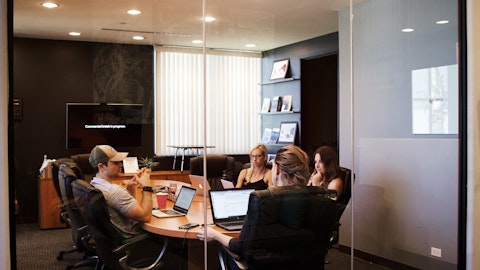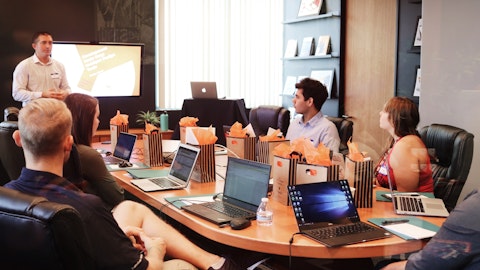Compañía de Minas Buenaventura S.A.A. (NYSE:BVN) Q1 2023 Earnings Call Transcript April 28, 2023
Operator: Good day, ladies and gentlemen, and welcome to the Compañía de Minas Buenaventura First Quarter 2023 Earnings Results Conference Call. At this time, all participants are in a listen-only mode, and please note that this event is being recorded. I would now like to introduce your host for today’s call, Mr. Gabriel Salas, Investor Relations. Mr. Salas, you may begin.
Gabriel Salas: Good morning, everyone, and thank you for joining us today to discuss our first quarter 2023 results. Today’s discussion will be led by Mr. Leandro Garcia, Chief Executive Officer. Also joining our call today and available for your questions are Mr. Daniel Dominguez, Chief Financial Officer; Mr. Juan Carlos Ortiz, Vice President of Operations; Mr. Aldo Massa, Vice President of Business Development and Commercial; Mr. Alejandro Hermoza, Vice President of Sustainability; Mr. Renzo Macher, Vice President of Projects; Mr. Juan Carlos Salazar, Geology and Exploration Manager, Mr. Roger Navies Chairman; and Mr. Raul Benavides Director. Before I hand our call over, let me first touch on a few items. On Buenaventura’s website you will find our press release that was posted yesterday after market close.
Please note that today’s remarks include forward-looking statements that are based on management’s current views and assumptions. While management believes that its assumptions, expectations and projections are reasonable in the view of the currently available information, you are cautioned not to place undue reliance on these forward-looking statements. I encourage you to read the full disclosure concerning forward-looking statements within the earnings results press release issued on April 27, 2023. Let me now turn the call to Mr. Leandro Garcia.
Leandro Garcia: Thank you, Gabriel. Good morning to all, and thank you for attending this conference call. We are pleased to present the results for the first quarter 2023 from Compañía de Minas Buenaventura. We have prepared a powerpoint presentation, which is available on our web page. Before we go further, please take a moment to review the cautionary statement down on Slide number two. Moving on to Slide three. Highlights were as follows. First quarter ’23 EBITDA from direct operations was $51.6 million compared to the $86.9 million reported in the first quarter of ’22. EBITDA results do not include $300 million from the sale of Buenaventura stake in Yanacocha. First quarter ’23 EBITDA, including associate company reached $181.9 million compared to the $233.7 million in the first quarter of ’22.
Again, EBITDA results do not include the $300 million from the sale of Buenaventura’s stake in Yanacocha. First quarter ’23 net income from continuing operations reached $72.2 million compared to US$134.7 million net income from continuing operations for the same period in 2022. Brocal or mine from its open pit was stockpiled during the first quarter of 2023 and was not treated during the quarter. Underground mine production increased to 9,350 tonnes per day during the first quarter ’23 compared to the 7,100 tonnes per day in the first quarter 2022 as part of the ramp-up to reach 10,000 tonnes per day during 2023. This stockpiled led and zinc ore will be treated at Brocal processing plant in the second quarter of 2023. Buenaventura’s cash position reached $173 million as of March 31, 2023.
Net debt increased to $556.8 million with an average maturity of 3.1 years. First quarter 2023, capital expenditures were $36.2 million compared to $19.9 million for the same period in 2022. First quarter 2023 CapEx includes $9.7 million related to the San Gabriel project, and $8.8 million related to Yumpag project. On March 24, 2023, announced a total dividend distribution of $250 million. Buenaventura will receive 49 million relative to its stake in rail on April 28, 2023. During the first quarter of this year, operations at Julcani were suspended for 10 days in February 2023 related to antigovernment protests, which adversely impacted production and mine development. Operations were fully established on February 16, 2023. The company plans to recover this production in subsequent quarters and expect to meet 2023 production guidance.
Moving on to Slide four, our financial highlights. Total revenues during the first quarter were $186 million, which is 20% lower in the comparison to the first quarter of 2022. As we mentioned before, our EBITDA from direct operations for first quarter 2023 was $52 million in comparison to $87 million during the first quarter of 2022. Again, these figures exclude the Uchucchacua transaction effect. Also, our net income from continuing operations for the first quarter of 2022 was $73 million in comparison to a net income from continuing operations of $135 million during the same period in 2022. The CapEx increased to $36 million in the first quarter of 2023 compared to the $20 million in the first quarter of 2022. Moving on to Slide five, attributable production.
Total gold attributable production in the first quarter of 2023 was 39,000 ounces, 21% lower than the figure reported in the same quarter of the previous year. This decrease is mainly explained by Latana mining operations expansion since the fourth quarter of ’22, and lower production at Coimolache as mining and ore stockpiling were temporarily suspended in the fourth quarter 2022. Silver attributable production for this quarter was 1.1 million ounces, which shows a decrease of 38% compared to the figure reported on the first quarter of 2022. This decrease in production was primarily due to the Brocal underground mine being the sole producing mine during the first quarter of 2023, as with the adverse impact of the 10-day suspension of activities at Julcani due to protest as described.
Finally, our copper attributable production for the first quarter of the year was close to 29,000 metric tonns, a 7% increase compared to the same period in 2022. Moving on to Slide six, all-in sustaining cost and cost applicable to sales. The all-in sustaining cost from our direct operations in the first quarter of 2023, increased by 44% to $1924 per ounce of gold. The cost applicable to sales for the first quarter of 2023 were as follows: for gold, US$1,124 per ounce, which is almost equal to a year ago. For silver, US$21.5 per ounce, which is 41% higher than a year ago for lead US$1,394 per metric ton, which is 1% higher than a year ago for copper. US$6,738 per metric ton, which is 2% higher in comparison to a year ago. Finally, in the case of zinc, the cost applicable to sales was US$1,966 per metric ton, which is 31% lower than a year ago.
Moving on to Slide seven, our pipeline of projects update. Here, we are presenting in one snapshot the current development level for each of our projects. Moving on to Slide eight. Our projects in the case of Yumpag, our brownfield project, we are focused on development of main ramps and exploration tunnels. Updated geological model suggests the opportunity to increase mineable grade with less mining development. Environmental permit for underground exploration granted in February 2023. Environmental permit for mining expected on May 2023. In the case of San Gabriel, our greenfield project, we have finished the organic contract. is to start in May and definitely come site to start in July. Authority admitted the power line environmental impact assessment currently programming the third workshop by the third quarter of 2023.
Working with the regional government or role maintenance and right of way, which we have reached an agreement with Codire community on oil transport fees. Thank you for your attention, and I will hand the call back to the operator to open the line for the questions. Operator, please go ahead.
Q&A Session
Follow Compania De Minas Bv Sa (NYSE:BVN)
Follow Compania De Minas Bv Sa (NYSE:BVN)
Operator: Our first question today comes from Carlos De Alba from Morgan Stanley. Please go ahead with your question.
Carlos De Alba: Thank you. Good morning, everyone. My first question is El Brocal and the stockpiles that you accumulated in Q1, how much under your process this quarter, you are processing this quarter. Can you offer some color as to how much volumes of lead and then will be sold during the second quarter from the stockpiles? Or would you really expect to see the volumes really coming only in the third quarter given that the processing will take place during the second quarter? And my second question has to do with the balance sheet and the free cash flow. The free cash flow in the last several quarters has been for the most part negative and your debt has increased. Net debt has increased and the maturity is only 2.1 years.
And so how do you – how are you going to address this situation. We’re getting more and more questions from investors that are concerned about the balance sheet. And Seroteis is paying dividends, but probably not as much as we would have thought. So yes, just any comments, maybe, Daniel, on how you’re going to address the situation? What are the plans that the company has in order to improve the balance sheet? That would be great.
Leandro Garcia: Thank you, Carlos, for your questions. First, in terms of Brocal, maybe Juan Carlos will give more color to the answer. But the thing is the – the order we have the stockpile there, we have a plan to pass through the plant during the year. And in terms of the free cash flow, we have some strategies of how to pass this negative quarter in terms of free cash flow. However, this third quarter has been characterized because of the using of working capital. Now we have used more working capital. We have not treated the ore, for example, in Brocal. And that – Daniel will give you for sure more information about how we turn our strategies for this coming year and all the projects we have in a row. And finally, the dividend of Serolerde we already have received the first part of the dividend.
We expect, for sure, during the year, normally, Freeport declare dividends, one in March and the second as an advance in October. So we should expect an additional dividend during the year. Please, Juan Carlos, if you can give more color to?
Juan Carlos Ortiz: Sure. We end up the first quarter of 2023 in Brocal with an average of 200,000 tonnes of ore in the stockpile. The focus was on stripping the operators of this asset that we are mining in the open pit. In the coming quarters, we will increase that volume of the stockpile up to around 1 million tons in the third quarter and then coming down by the end of the year to finalize this year with around 400,000 tons of ore in stockpile. By the first quarter of 2024, we will complete the processing of this material. The material is mainly poly-metallic with areas that contain copper because we’re getting closer and closer to the underground mine that is mainly copper. This is pretty much the same transition that we see in open pit.
The volumes of lead that we are going to be producing are in line with our guidance for the year. So it’s only the sequence of mining up to September and the sequence of processing all the way down to the last quarter of this year and first quarter of 2024. So at the first quarter of 2024, we will finalize the processing of the outstanding stockpiles or from the open pit in Brocal. And our next question – sorry, the second part of the answer of the question from Carlos. Thank you, Carlos, for your question. Yes, temporarily, we are having a deterioration of our leverage ratio. It’s over 3 times right now. But we believe this will be reducing in the following quarters when we have better EBITDA. During last year, the second EBITDA of 2022, which is counted within the period of this ratio, we had a very low EBITDA.
And we believe in the second half – second quarter and the third quarter with Brocal improving operation with – after treating the stockpile that Juan Carlos mentioned, we are going to recover the EBITDA. Meanwhile, to be able to fund impact and San Gabriel, we are going to use our own cash, but also we are going to raise a temporary facility that we have already committed with local banks. This could be up to between $50 million and $100 million. This will permit us to fund temporarily our obligations in Yumpaq and San Gabriel. And we will see if we need to extend this – the maturity of this loan. However, we believe that with the dividends also that we will receive – we will receive at the end of the year. After starting Uchucchacua and Yumpag in the third and fourth quarter, we will be able to finish the year with a leverage ratio of below 3.5 times.
For next year, we’re having to tap on Yumpag working at full capacity and a better – and having a better EBITDA, we think that the leverage ratio should go down to levels of three times.
Carlos De Alba: Thank you. Just one question on the working capital in the quarter. Leandro alluded to that. But actually, the biggest negative impact that we can see is not on inventories. It is on trade and other accounts payables, so almost $80 million negative impact. Any particular reason why such a big delta in that line?
Juan Carlos Ortiz: Yes, Carlos. As you remember, last year, we experienced the same situation. In December, we registered a big amount of bills from contractors, basically at El Brocal and Tambomayo. These were registered at the end of the year and were paid during the first quarter of the year. So this is a temporary effect as well.
Carlos De Alba: Thank you.
Operator: And our next question comes from Tanya Jakusconek from Scotiabank. Please go ahead with your question.
Tanya Jakusconek: Good morning, everyone. Thank you so much for taking my question. I actually have three. Just for Daniel, can Daniel, I know at your Investor Day and your materials, you gave guidance for Sierra Verde dividend to be about $120 million per annum for you for the next sort of 3 years. Is that still a good number for us to use?
Daniel Dominguez: Yes, Tanya. We think that with the levels of the copper price right now. So where is generating a very important cash flow. We believe that the amount of dividend should be between $100 million and $120 million per year.
Tanya Jakusconek: Okay. And then, Daniel, there’s been no change to your capital cost guidance that you provided earlier this year?
Daniel Dominguez: Not at this point in time. We are still evaluating any effect at San Gabriel. But at this point in time, we maintain the same level of CapEx for this year.
Tanya Jakusconek: Okay. and so can I just come back to San Gabriel. And then my final question is actually back to El Brocal. But just on San Gabriel, you mentioned that we have – so you’ve done the camps. You’re doing the carline EIA. And then we have the third workshop. Can – I thought we were totally permitted on this project. Can you remind me what the third workshop is? And am I getting a permit with this third work shot? I’m just right confused.
Daniel Dominguez: Thank you, Tanja, for your question. The permit, we mentioned last year the construction permits. But well, here with Renzo Macher, our Vice President of Projects, so he can explain in detail the following part.
Renzo Macher: Yes. Hi. So land resin we do have the construction permits and environmental permits for the mine. What we’re talking here is about the permit for the power line. We do have – the process of this is, first, we get all the land, we already have all that. We have the design ready done. And now it’s about the environmental impact as of the line, which is different than the environmental impact assessment for a mine. So it’s a different regulation. So it’s two different permits.
Tanya Jakusconek: Okay. Sorry, I misunderstood. I had assumed we had all of the permits to go. So this is just a power line permit and that you’re doing the consultation with the communities is how I’m understanding it, and that’s going to be happening in Q3 ’23. When are you expecting the power permit then?
Renzo Macher: All right after that. That’s a different regulation. Yes. Towards the end of the year, we’re going to have the construction permit for the power line
Tanya Jakusconek: Okay. All right. Is that the last permit I need? Because you have the construction, you have the environmental, this power permit? Is that pretty much it in terms of the big permits?
Renzo Macher: Yes.
Daniel Dominguez: There’s a lot of operations – small permits and yes. But the biggest one, yes.
Tanya Jakusconek: Yes. No, I understand every the permits here and there, but the bigger ones. Okay. And is the power line permit on critical on the time line to get into production by mid-2025?
Renzo Macher: No, it is not.
Tanya Jakusconek: No.
Renzo Macher: No. We do have like a 6 monthly in the time.
Tanya Jakusconek: Okay. So you could start up with generators is sort of what I understand?
Renzo Macher: Yes. It is always optimal to do it with the power line, but yes.
Tanya Jakusconek: Yes. Okay. No, for sure, for sure. Okay. Thank you for answering that. And then maybe for Daniel, again, sorry, Daniel. Just my understanding on El Brocal and how we should model it in our model, so I get the right cash flow coming out of this asset for you. Should I just be thinking this year like until Q3, we are mining like the copper from the underground. And then the lead and zinc stockpile, which you’re increasing the stockpile from 200,000 tons to 1 million, should I be thinking that, that then starts to majority of it get come off in Q4. So that get processed and revenue comes in Q4 and Q1 of next year, is that the majority of the revenue coming out from that stockpile and the copper just comes and goes through this year. So two things. copper revenue coming through the entire year, where the lead and the zinc is coming in Q3 – sorry, Q3, Q4 and Q1 of next year. Is that how I should think about it?
Daniel Dominguez: Maybe, Juan Carlos can explain the process of how we are going to explore work with Brocal.
Tanya Jakusconek: How the revenues and the cash flow is coming through quarterly.
Juan Carlos Ortiz: Can you say that Tanya — the processing of the poly-metallic ore is starting now in April. The speed at which we are mining is higher than the processing rate. That’s the reason that we are start building up some additional stockpile. But at the same time, we are processing the ore. In that situation, we will reach a peak of about 1 million tonnes of stockpile by the third quarter. Then we stopped the mining of the open pit, and we’ll start processing the outstanding stockpile. And as I mentioned, that the stockpile will be completed processed by the first quarter of 2024. But we started now in April. We start the processing of the poly-metallic. So the revenue coming from the single lead concentrates is starting now in April, and it will continue up to the first quarter of next year.
Tanya Jakusconek: Okay. Okay. And that’s the lead and zinc is already in your 2023 guidance you gave us in your pre-release. So I should think about that lead and zinc, whatever the guidance is to be now sold from Q2 up to year-end?
Juan Carlos Ortiz: That’s correct. That’s correct.
Tanya Jakusconek: Okay. That makes sense to me. Thank you so much. I really appreciate you taking my questions. Thank you.
Operator: Our next question is a follow-up from Carlos De Alba from Morgan Stanley. Please go ahead with your question.
Carlos De Alba: Thank you. Just on Yumpag, if I may ask. Where do you guys stand in terms of the permits? And what is sort of the deadline that you internally have to receive these permits and still be able to ramp up the operations in the fourth quarter or start ramping up the operations in the fourth quarter or later this year?
Leandro Garcia: Carlo, let me ask you which permits do you – Yumpag, Uchucchacua…
Carlos De Alba: Uchucchacua…
Leandro Garcia: Okay. Okay. Well, maybe Alejandro, we are in line what we have talked and explained to the market, we are in line with our times. But however, Alejandro can give you the details of which will be the time frame of – in order to restart Uchucchacua and begin Yumpag, please.
Alejandro Hermoza: Yes. Thank you, Carlos. Okay. We have two different situations. Uchucchacua has no major issues in terms of permits. We just have to – on due time do the procedures to restart the operations. So that’s not a major issue. On the Yumpag side, what we have were on the final stage of getting the approval for the environment assessment study that the main environmental permit that we have. And we should be able to get that approval. We should have gotten already, but we should get it by May – within May, we should get that approval. After that, we need to go into the Ministry of Mines to get the construction permit, and it should take us a few months, a few months more. It’s just an issue of bringing all the parts together, and we should have a permit for the first phase of the project. That would be by the on time as it was scheduled.
Leandro Garcia: Okay. And sorry, just when would you expect to get the construction permit for Yumpag?
Juan Carlos Ortiz: Yes. We expect to have the – we already are developing the mine at Carlos. We are running the ramps, running the accesses. With the license that we expect to have in May, in 4 or 6 weeks down the road, we will start to develop the ore body. In May, we will start hitting the ore body and start making galleries through the ore bodies in a very high-grade areas about 20 to 25 ounces of silver. So we will start developing that. In order to transport the ore from the Yumpag area, per kilometers to the processing plant of Uchucchacua will be an additional permit, and we expect it to have it by the end of this year 2023 or the first quarter of 2024. Of course, we are doing our best to try to speed it up and try to get the permit by the last quarter of the year 2020.
So to put this 23, 25 ounces of silver into our balance sheet by the end of the year. That’s Yumpag. And in parallel, we are doing some developments, new developments underground in Uchucchacua mine to access new areas that we have discovered in the last 12 months, 18 months. And there are a different blend of silver, lead and zinc, more now into the probably seeing led than silver. So it’s more polymetallic or good value. And probably, we will start — we are doing now the developing of these stopes. We are producing some small stockpiles of ore so far, and we expect to start the production of the processing plant on Uchucchacua by October. So pretty much the 2 operations, Yumpag and Uchucchacua by the end of the year, we start turning into production.
Carlos De Alba: And just one just to clarify, the construction permit in Yumpag that you still need is really just for the transportation of the ore to the Uchucchacua plant?
Juan Carlos Ortiz: Yes. It’s a permit actually — because the — we have all the permits for the mine development for the comps, for the power line or the acceding is mostly done. — but for transportation between the unpack site to the processing plant of Uchucchacua 12 kilometers along the highway. We need to get an additional permit and also for processing commercialization of the concentrate that we will producing. So that’s the final permit that we will require to put them officially into production.
Operator: And ladies and gentlemen, that will conclude today’s question-and-answer session. I’d now like to turn the floor back over to Mr. Garcia for closing remarks.
Leandro Garcia: Thank you. Thank you for attending this conference call. I have to mention that yesterday, we have our seventh anniversary as Compañía de Minas Buenaventura. And we are very proud to be part of this family. And we have to go further with our efforts to get in all our projects and all our work for our company, for our collaborators for our content. Thank you very much, and have a good day.
Operator: Ladies and gentlemen, that will conclude Buenaventura’s First Quarter 2023 Earnings Results Conference Call. We would like to thank you again for your participation. You may now disconnect your lines.





